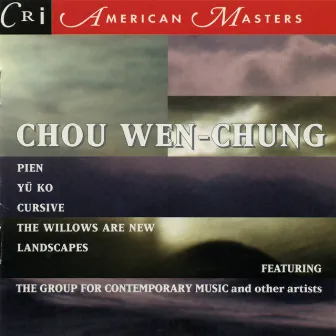Performance
Monthly Listeners
Current
Followers
Current
Streams
Current
Tracks
Current
Global Rank
Current
Listeners 151
Top Releases
View AllBiography
There has, for many years, been a trend in music towards the fusion of traditional European/American values, forms, and styles with Pacific Asian music. Today, the trend has perhaps become commonplace and sometimes even hackneyed, but when Chou Wen-chung moved from China to the United States after World War II and began to study the traditions of both Eastern and Western music, such a fusion was anything but. Chou Wen-chung was born in Chefoo, in July 1923 (note: as per Chinese tradition, his name is Chou Wen-chung, not Chou, Wen-chung or Wen-chung, Chou). As a young man, he prepared for a career as an engineer, taking an undergraduate degree in that field while still living in China. He moved to New Haven, Connecticut, in 1946 to enroll in the architecture school of Yale University, but he tired of his studies after a year or two and was soon spending nearly all of his time building musical skills under the tutelage of the well-known Nicholas Slonimsky. Chou also received the benefit of Edgard Varèse's teaching (later becoming the musical executor of Varèse's estate and living in the house that had belonged to Varèse), and eventually took a master's degree in composition from Columbia University in 1954. Post-graduate studies included research on Chinese music and serving as Columbia's Electronic Music Laboratory's first technical assistant. From 1964 on, Chou taught at Columbia University, also serving in the administration of the University's School of Arts. Among his students were Bright Sheng, Tan Dun, Chinary Ung, and Zhou Long. He was as energetic an organizer as he was a composer and teacher, and he lent this energy to several notable American organizations, including a stint as president of CRI, Inc., founding the Fritz Reiner Center for Contemporary Music, and founding and directing the Center for U.S.-China Arts Exchange, which assisted in sending Isaac Stern and Luciano Pavarotti to perform in China. He continued to write and lecture extensively on the integration of Eastern and Western musical concepts and practices, as well as on Asian and contemporary music, after his retirement in 1991. In his music, which is not plentiful (he stopped composing altogether during the 1970s and early 1980s), Chou Wen-chung took up elements of Chinese tradition, folklore, and/or history and applied them to works scored for traditional Western ensemble types. Unlike Toru Takemitsu, who might have inserted a traditional Asian instrument (the shakuhachi, for example) into the ensemble, Chou seemed content to transplant the sound patterns of his source -- say, Chinese zither music -- onto the piano keyboard (he did precisely that, in fact, in the 1957 solo piano work The Willows are New). He also sought to apply something of the principles and mysteries of the I Ching to his music (for example, in the 1966 orchestral work Pien). Beijing in the Mist (1986), a chamber work for ten players, was the first piece to appear after the retirement of the 1970s and '80s, and Chou Wen-chung followed it up with a Cello Concerto (1992) and a handful of chamber scores. Only in his last works did Chou utilize Asian instruments. Eternal Pine (2008) was a commission by a gayageum ensemble. He then modified it as Ode to Eternal Pine (2009) for Western instruments and as Eternal Pine III (2012) for Chinese instruments.







